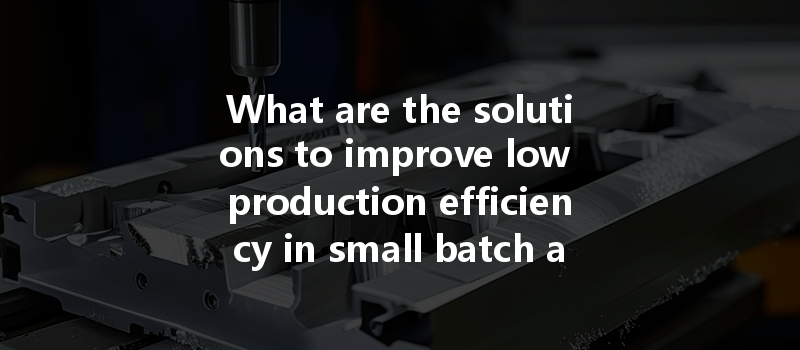Have you ever considered how the tiniest of adjustments in machinery can lead to a significant impact on production efficiency? According to a recent study from the International Journal of Advanced Manufacturing Technology, small improvements in the workflow of CNC machining can enhance production rates by up to 30%. For those closely involved in operations, this statistic is not just numbers but a call to action.
In the world of manufacturing, CNC (Computer Numerical Control) machining serves as a foundational technique that shapes the very materials we interact with daily. However, the unique challenges presented by small batch and multi-variety machining can cause a bottleneck in production, hindering companies from reaching their full potential. This blog aims to address those challenges and propose effective solutions to enhance production efficiency in CNC machining.
—
Understanding the Challenges of CNC Machining
Before diving into solutions, it’s essential to understand the challenges that accompany small batch and multi-variety CNC machining:
Understanding these challenges allows us to tailor solutions specific to CNC machining, aiming to smooth out the intricate processes involved.
—
Solution 1: Optimize Tooling and Setup Times
1.1 Use Quick Change Tool Systems
Applying quick change tooling systems can minimize the time spent switching tools between jobs. This allows operators to significantly reduce downtime during setup and changeover. Tool holders and automatic tool changers can facilitate swift transitions to cater to different part designs.
1.2 Pre-Setting Tools
Before a new job begins, ensuring that tools are pre-set can drastically reduce the time taken for each setup. By using a tool presetter, operators can establish all necessary dimensions beforehand, allowing them to quickly switch tools with precision.
1.3 Standardization of Tools
Using standardized tools across multiple projects can significantly reduce complexity. By consolidating tooling requirements, operators can keep fewer tools on hand, which translates into less time spent on inventory and setup.
—
Solution 2: Implement Lean Manufacturing Principles
2.1 Identify and Eliminate Waste
Embracing lean manufacturing principles opens up pathways for streamlining processes. Identifying waste points—whether that be excess motion, waiting times, or over-processing—is key. For CNC machining, this may involve mapping the workflow and employing methods like value stream mapping (VSM) to visualize and eliminate inefficiencies.
2.2 Continuous Improvement Culture
Creating a culture of improvement encourages employees to contribute ideas and solutions to enhance efficiency. Regular meetings or feedback sessions can empower staff and create a sense of ownership over the process.
2.3 Batch Sizing Optimization
Adjusting batch sizes can also contribute to better efficiency. Smaller, more frequent batches can minimize wasted time while ensuring tools are always in use, reducing lead times significantly.
—
Solution 3: Invest in Advanced Technology
3.1 Use of CNC Software and Automation
Investing in advanced CNC software solutions that include simulation and scheduling can improve setups and tooling usage. Software tools facilitate planning and make it easier to visualize how processes can change to improve efficiency.
3.2 Automation and Robotics

Automating manual tasks eliminates bottlenecks in production. Automatic loaders and robots can handle the material input and output, allowing CNC machines to run continuously without operator intervention.
3.3 Real-time Monitoring
Utilizing Intelligent Manufacturing systems allows for real-time monitoring of production lines, helping identify inefficiencies immediately. This visibility enables rapid response interventions, thereby preventing delays.
—
Solution 4: Improve Employee Training and Skill Sets
4.1 Cross-Training Employees
Cross-training allows employees to function in multiple roles, enhancing operational flexibility and decreasing downtime. When every operator understands each function, it maximizes efficiency, especially during periods of unexpected absences or high demand.
4.2 In-House Training Programs
Establishing in-house training programs can ensure that staff is up-to-date with the latest CNC advancements and tools. This can involve workshops with hands-on experiences to keep engagement high.
4.3 Consistent Performance Tracking
Regularly assessing employee performance can highlight strengths and weaknesses in the workforce. Data gathering through performance reviews will help in tailoring training programs effectively.
—
Solution 5: Quality Control Techniques
5.1 Implementing Statistical Process Control (SPC)
SPC is crucial in the CNC field. By monitoring processes through statistical methods, businesses can catch deviations early, reducing defective outputs. Implementing SPC requires regular data analysis to adjust processes in real time.
5.2 Adopt Quality Circles
Encouraging employees to form quality circles fosters an environment of collaborative problem-solving. By discussing issues experienced during production, team members can propose innovations and tools to enhance quality and efficiency.
5.3 Invest in Testing Equipment
Investing in top-notch quality control machinery, like coordinate measuring machines (CMMs), can help detect inconsistencies early in processing, minimizing rework and ensuring final product integrity.
—
Solution 6: Smart Inventory Management
6.1 Just-In-Time (JIT) Inventory
Implementing a Just-in-Time inventory management approach allows materials to arrive as they are needed. This minimizes inventory costs and mitigates downtime from material shortages.
6.2 Supplier Relationships
Cultivating strong relationships with suppliers ensures that you can react quickly in case of unexpected material needs. These relationships can also provide opportunities for bulk purchasing discounts.
6.3 Digital Inventory Tracking Systems
Using digital systems to track inventory in real time can provide valuable data. This analysis can predict demand patterns and facilitate better stocking strategies.
—
: The Path Toward Efficiency
Improving production efficiency within small batch and multi-variety CNC machining is no small task, but with the right approaches, significant advancements can be made. By optimizing tooling and setup times, embracing lean manufacturing principles, investing in technology, enhancing employee training, implementing stringent quality control measures, and managing inventory smartly, businesses can open avenues for smoother production processes.
So, why should this topic matter to you? In a manufacturing landscape where speed and quality dictate success, the techniques outlined in this blog serve as powerful mechanisms to elevate your operations beyond current limitations. Embracing these solutions not only propels productivity but ultimately fosters a culture of innovation and excellence in your organization. Now is the time to rethink CNC machining processes—for your efficiency depends on it.



